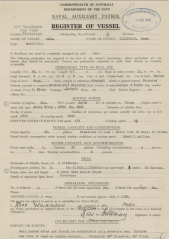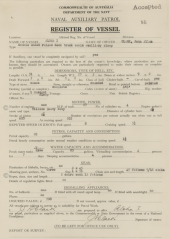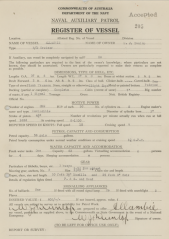The Naval Auxiliary Patrol
The Naval Auxiliary Patrol (NAP) was a war-raised unit approved on 25 June 1941. It, along with a number of channel patrol boats, was charged with patrolling and safeguarding Australia's inner harbours, ports, rivers and estuaries against enemy sabotage or attack.
Prior to June 1941, two organisations, the Volunteer Coastal Patrol (VCP) and the National Emergency Service Yachting Auxiliary (NEYSA), carried out patrols in New South Wales, Queensland and Victorian waters. These two organisations comprised patriotically minded yachtsmen who worked in an entirely honorary capacity and provided their own boats. This changed after the NAP was formed when members were sworn in for full or part time service. Those volunteering for full time service became members of the RAN and received naval rates of pay and wore naval uniform.
In May 1942 the NAP was transferred to the Royal Australian Naval Volunteer Reserve (RANVR) and was thereafter known as the RANVR NAP. By October 1942 the total strength of the NAP had increased to over 3000 mobilised and unmobilised reserves. This was to remain the case until early 1944 when it was considered that the danger of enemy attack was remote enough to reduce the strength of the NAP to a minimum.
NAP members wore their own distinctive uniform and held the relative rank or rating as indicated in the tables below:
| NAP | RANVR | NAP | RANVR |
| Squadron Skipper | Lieutenant-Commander | Recruiting Officer | Sub-Lieutenant |
| Flotilla Skipper | Lieutenant | Cadet Skipper | Sub-Lieutenant |
| Surgeon Skipper | Lieutenant | Skipper (Boat owner confirmed) | Sub-Lieutenant |
| Chaplain | Lieutenant | Skipper (Non boat owner and not in command of a vessel) | Sub-Lieutenant |
| Squadron Engineer Officer | Lieutenant | Skipper (Non boat owner and not in command of a vessel) | Chief Petty Officer |
| Divisional Skipper | Sub-Lieutenant | Skipper (Boat owner probationary) | Chief Petty Officer |
| Instructional Officer | Sub-Lieutenant | Senior Mate | Petty Officer |
| Communications Officer | Sub-Lieutenant | Engineer (Divisional) | Petty Officer |
| Military Liaison Officer | Sub-Lieutenant | Signal Instructor | Petty Officer |
| Liaison Officer | Sub-Lieutenant | Other Instructors | Petty Officer |
| Accounting Officer | Sub-Lieutenant | Mate | Leading Seaman |
| Regulating Officer | Sub-Lieutenant | Signal Mate | Leading Signalman |
| Survey Officer | Sub-Lieutenant | Sick Bay Attendant | Able Seaman |
| Staff Skipper | Sub-Lieutenant | Seaman | Able Seaman |
| Area Skipper | Sub-Lieutenant | Clerk | Writer |
Uniforms approved for members of the NAP consisted of the following:
| No. 1 Rig | Blue double breasted reefer jacket (8 NAP Buttons), blue trousers with cuffs, white shirt, black tie, blue cloth peaked cap and brass NAP cap badge, black shoes and socks. |
| No. 2 Rig | Reefer jacket, as above, grey trousers with cuffs, grey tie, blue, long sleeved shirt with shoulder straps and two pockets, black shoes and socks (white sandshoes afloat) |
| No. 3 Rig | Same as No. 2, but without reefer jacket, and tie tucked into shirt |
| No. 4 Rig | Same as No. 2, but without reefer jacket, and woollen navy blue lumber jacket worn in lieu |
| No. 5 Rig | Khaki, grey or white shorts worn by all ranks as a working dress during summer months |
* Nos. 3 or 4 Rig were the only rigs to be worn by any Cadet member under the age of 18 years.
By the end of 1944 most of the boats that had been bought by the Navy for NAP duties had been resold or returned to their original owners.
On the following pages you will find a collection of surviving registration papers and records for many of the small vessels requisitioned by the RAN.
Alert: These pdf documents have been created from scanned images and accordingly are large in file size. They may take time to download.










